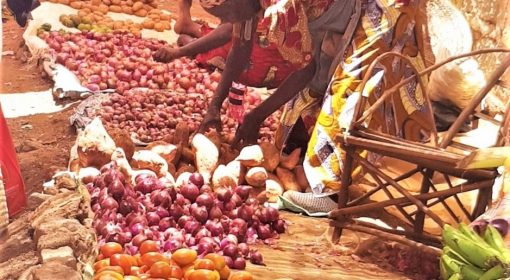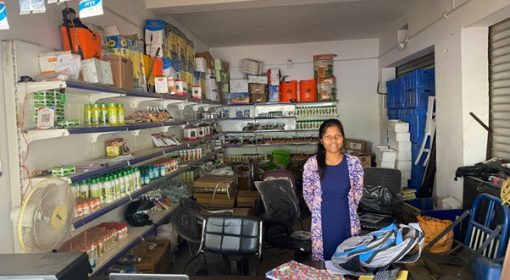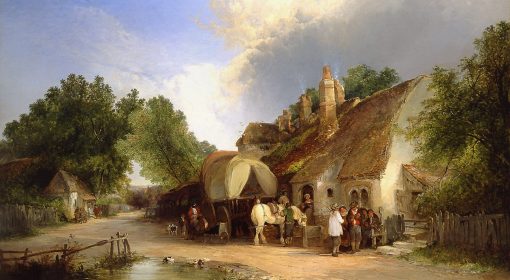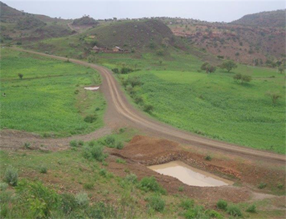Frank van Steenbergen, Rommert Schram, Abraham Abhishek, Jean Marc Pace Rici
October 21, 2020
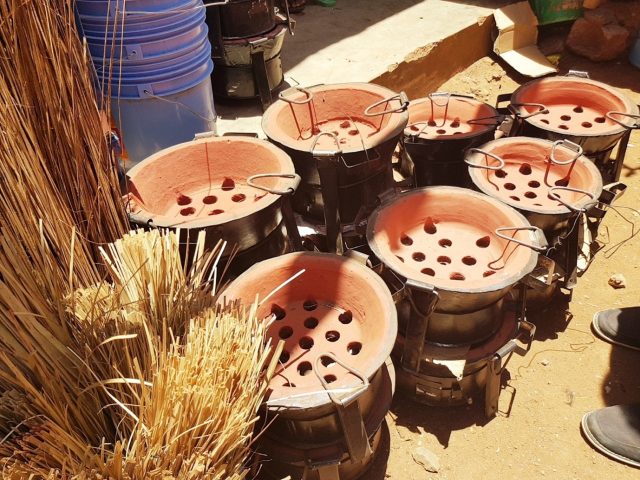
In many poor rural areas, there is no scope to operate in the world market: no scope to compete with China for consumer items, no scope to outbid India’s strength in things like software development, no scope to conquer a niche in the global food industry. In addition, the national economy may have limited scope to absorb quality rural produce. Moreover, it is hard for rural producers to access such urban markets as they are faced with thickets of inconsiderate middlemen. Instead of focusing on global opportunities, the main avenue of improvement is in strengthening the local economy – to create more jobs and better livelihoods with what goes around in villages and local districts.
At present the local circulation of goods and services is far from optimal. Not much value is added to agriculture, the main producing sector, either in the form of providing inputs or processing products locally. For many crops there is no market and quality has no value. Processing, grading, and product enhancement is not common. Furthermore, some products that used to be produced locally – such as processed food and household items – have lost their position to competition from industrial soft drinks, snacks and plastic items. What is left behind is an eroded local economy.
What can be done to promote a strong local economy and reverse this downward trend? Given that agriculture is still the economic mainstay in rural areas, what can be done to vitalize rural economies?
Focus on local value chains
Well-functioning local value chains are at the heart of the local economy. They can prove to be the difference between an economy at standstill and one that is vibrant with a high level of services. If local value chains function well, the chain of locally provided services is long and money circulates in the local economy. They ensure the circulation of all marketable commodities including byproducts, and keep value from getting lost. Food security is high, as is the quality of life in general. Jobs are created in input supply, in trade, transport and processing. This adds value and that value keeps going around in the local economy.
On the other hand, if local value chains do not work well, circulation is erratic or blocked. Many products do not circulate or they get lost because of lack of storage or transport. The level of useful services is low – and although jobs could be created, they are not. There is little value addition and the local economy simply just does not move.
What can be done to promote local value chains? There are four main directions:
- Creating more diversity and added value
- Increasing the circulation of money
- Improving connectivity with roads and transport
- Fostering entrepreneurship
Adding value and creating more diversity
In many agricultural economies there are typically few locally produced agri-inputs (such as bio-fertilizer, soil improvement additives, compost, bio-pesticide, rodent control measures, locally selected seeds, etc). Agriculture can benefit a lot from better inputs that are locally produced, from local seeds to bio-fertilizer. These products and services have a two-fold impact; not only do they open up niches for local employment, but they also contribute to improving the quantity and quality of production and increase the value created by the producer. Many of these local inputs will be regenerative: they will form an agricultural system that is based on low external inputs that renews and improves on its own strength. The production of all these inputs, if done well, helps to get much more out of land, water and labour.
There is also little value-addition to the primary product once it is harvested. The proportion of crops in poor rural areas currently lost pre-harvest and post-harvest is staggering: 8-12%, sometimes even more. There is little storing, grading, processing; even though these activities reduce losses and present a huge local business opportunity. The skills and business awareness for these added value activities may not be there for various reasons: awareness, education, regulation, lack of entrepreneurship, or absence of financial reserves. However, all these blockages can be addressed and removed. In many areas the educational system is leading students away from business orientation and artisanal skills, and is typically preparing people for jobs that do not exist in large numbers. It comes as no surprise that in many countries young people see no future in agriculture. Nevertheless, all the value addition activities described above may make farming and agri-services more aspirational.
Next to agriculture, the second base in rural economies is consumer spending. In many rural areas there is little on offer in local consumer services and goods. Food is monotonous and not attractive, there is little entertainment, housing is sub-standard, health services are somewhere else, as is quality standard education. This is a pity because such services or goods could improve the quality of life – be it in better food, housing, education, health, household items, entertainment, ceremonies and spiritual care. Where such services do exist, opportunities are created, jobs materialize and chances to earn money and spend again are created. It helps to spin around money and create multipliers.
Hence, there is a clear need to improve the diversity of local consumer products and services and add more value, diversity and pleasure. It is necessary to stimulate such new activities through training, credit lines, and assured supply till they are part of the more diversified rural economy.
Increasing the circulation of money
A second area to improve in local economies is cash flow. A common phenomenon in many rural economies is that they are heavily undercapitalized. There is not much money to go around – to pay for services or equipment. If one adds up all the cash that people in a village or rural district have it may amount to very little. There may be other systems such as bartering. With little money in circulation, there will be few shops that can sell things, even necessary items. It is not a matter of demand or even purchasing power, it is a matter of no supply and not enough on offer. Thus rural areas may have small grocery shops and pharmacies but no hardware shops, no agri-input shops, and few shops that sell consumer items.
Fortunately, there are many ways to inject money into local economies. Remittances are an example. The more effectively these are converted into local cash the better. In this case the M-pesa system in Kenya is exemplary. With a click on the mobile phone relatives can send money to family members in rural areas, who can then retrieve cash locally, which can fuel the local economy.
Money can also be created locally in the shape of circular credit. People deliver services or goods to one another but are not immediately paid. When some cash is injected into the local systems these claims may be settled and in the meantime people can transact with one another on the basis of trust. Another classical way of getting money into a local economies are employment programs, provided that people are paid in cash and not with imported food. The trick is not only to get money into the local economy and have it circulate fast over a range of local producers and service providers, but also to make sure that money does not leave the local economy – that consumers for instance spend it on local housebuilding rather than on imported consumer items. It is particularly effective to stimulate local service providers that cater to basic needs: housing, health, quality food, education, and in all things that contribute to a good quality of life.
Roads, transport and marketplaces
A third area of strengthening local value chains is physical: roads, transport, storage facilities, preservation units, market places, shops, processing units. Roads make all the difference. They unlock the economy – they make it possible for commodities to be sourced from new areas, for local products to go to all corners. They also make it possible to market items that before were not even part of the economy, such as by-products and chaff. Roads have been found to strengthen the economy just by ‘being there’. A very recent study by the World Bank[1] in Ethiopia found that:
- Development of rural roads increased, on average, household consumption by 16.1 percent between 2012 and 2016 (or 3.8 percent per year).
- The effects of rural road development were largest in the most remote communities. Here they increased household consumption by 27.9 percent.
- In communities most affected by drought, the likelihood of falling into poverty was 14.4 percent lower between 2012 and 2016 if the community was connected by a rural road.
This shows that just by building rural roads, the local economy benefits tremendously. However, by making optimum use of these roads, the impact can be increased. If the roads are used for transporting locally produced crops and goods by trucks, mini-buses and particularly, motorbikes and tricycle carriers the local economy gets another boost. Specifically motorbikes can penetrate into the most remote hamlets – even move on the small foot paths – and unlock the local economy.
In addition, well-organized market places with proper scales, shelters against sun and rain and godowns accommodate an optimum exchange of crops and goods, and prevent wastage. Cold storage and preservation facilities can make products available over an extended period, and avoid distress sales or outright dumping.
All this will create useful jobs and the income that comes with such jobs will further boost the local economy. In general, it should be easy to open shops and small production centres and do transport business. Programs should stimulate these. Regulations should be enabling and conducive, not complex and prohibitive.
Entrepreneurship
The final element is to promote entrepreneurship. Entrepreneurship can drive diversity and can unlock talents that were hidden before. Entrepreneurship adds to the diversity of services and makes the local value chains move smoothly.
In many rural areas starting a business and running it successfully is – unfortunately – not high in young people’s priority lists. There are many reasons – education, access to capital, networks. But one important reason is also aspirational. As more people pass through formal education systems the ambition becomes to enter government service or the NGO sector, but not to become one’s own boss. An effort is required to change the perception—through the education systems, as well as by positioning successful young entrepreneurs as role models.
Conceiving a model for boosting rural economies
Rural economic development is not a novel goal for governmental or non-governmental organisations. However, the focus so far has been limited to big-ticket agricultural infrastructure development (such as irrigation projects), or social safety net programmes. Crucial as these goals are, it is time to look at rural economies as the multi-component, diverse, self-sufficient systems that they are, and that they can be. It is necessary to acknowledge that these rural communities are not solely providers of agricultural produce to the rest of the country.
Based on experiences in Uganda, Ethiopia, and Kenya, the Green Future Farming project is designed to strengthen rural economies by diversifying the products and services on offer in the project areas. This requires an investment in training for various agri-products and services, building up the entrepreneurial capacity of local farmers, women, and youth as well as facilitating their access to credit and finance.
Trough the project, we have picked out some key interventions that not only boost agricultural production, but also set up and strengthen local value chains and provide rural communities with the skills to leverage them and build stronger, more diverse local economies. The successful implementation of these interventions will increase the volume of local transactions, kick-starting the circular flow of finance and resource within the communities, and ultimately leaving being economies that continue to thrive based on their own strength and resilient to external shocks.
The interventions will include:
- strengthening the natural resource base (landscape restoration, water harvesting),
- supporting farmers/pastoralists to develop good quality agricultural inputs as new product lines (seed banks, biofertilzer and biorodenticide production, and vermicomposting)
- promoting improved storage and post-harvest solutions (milk coolers, rodent management)
- improved product processing for higher-value output (homestead coffee processing solutions)
- developing supplemental income streams (homestead poultry keeping)
- promoting intermediate means of transport (of produce and people)
- facilitating access to capital, credit, and markets
This holistic approach to vitalizing the rural communities and economies we work with targets multiple of the issues described above. Some of these activities build upon pre-existing initiatives such as landscape restoration, and some fill in the gaps identified for creating self-sustaining circular economies. This approach is being adopted to ensure that bottlenecks to economic stimulation are addressed and converted to opportunities for employment, capacity development, and personal growth. We have high hopes for the Green Future Farming project achieving its goal of creating a better quality of life in our project areas in East Africa through landscape rehabilitation and rural economic interventions, unlocking the great potential that these communities hold.

